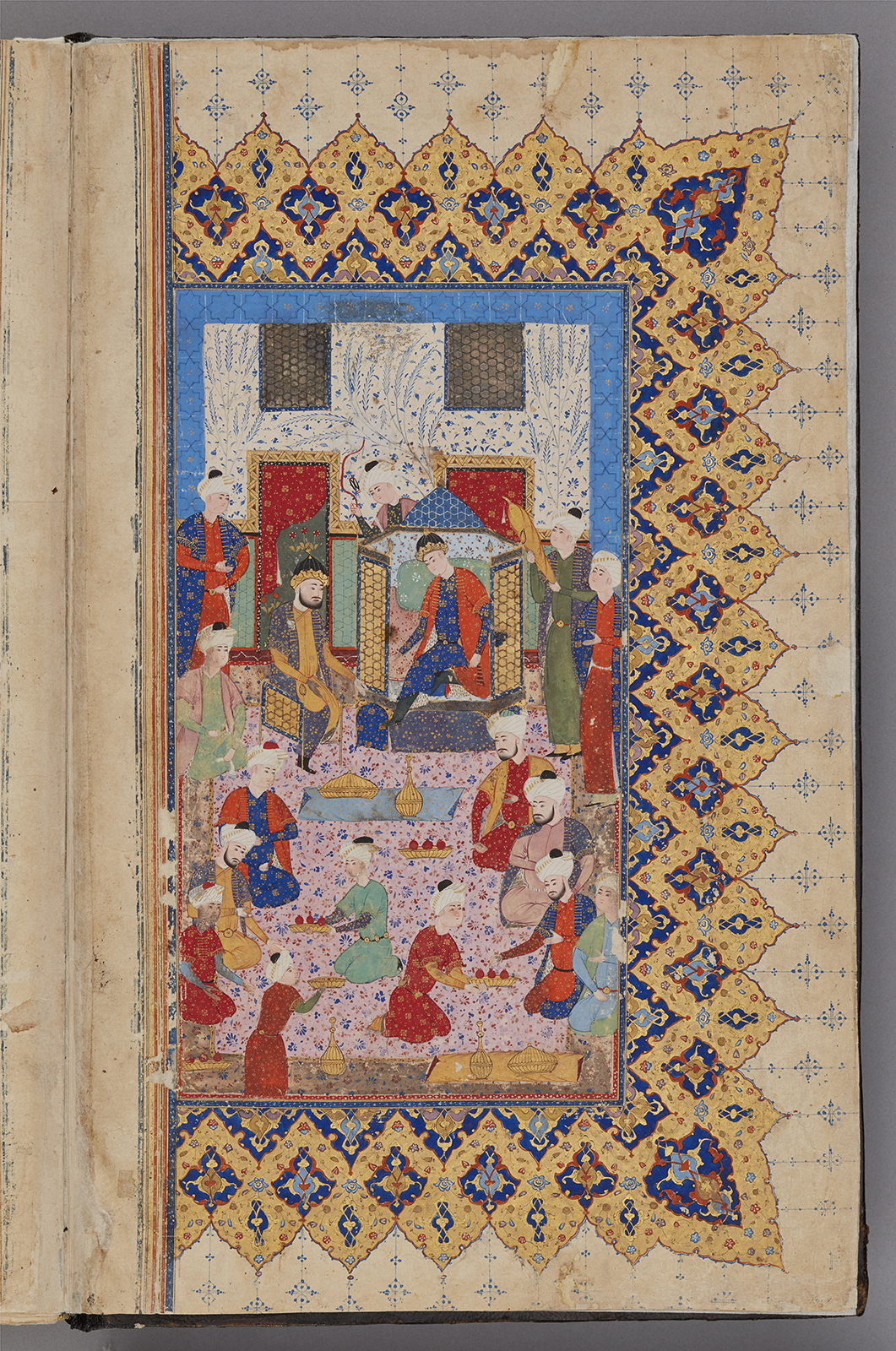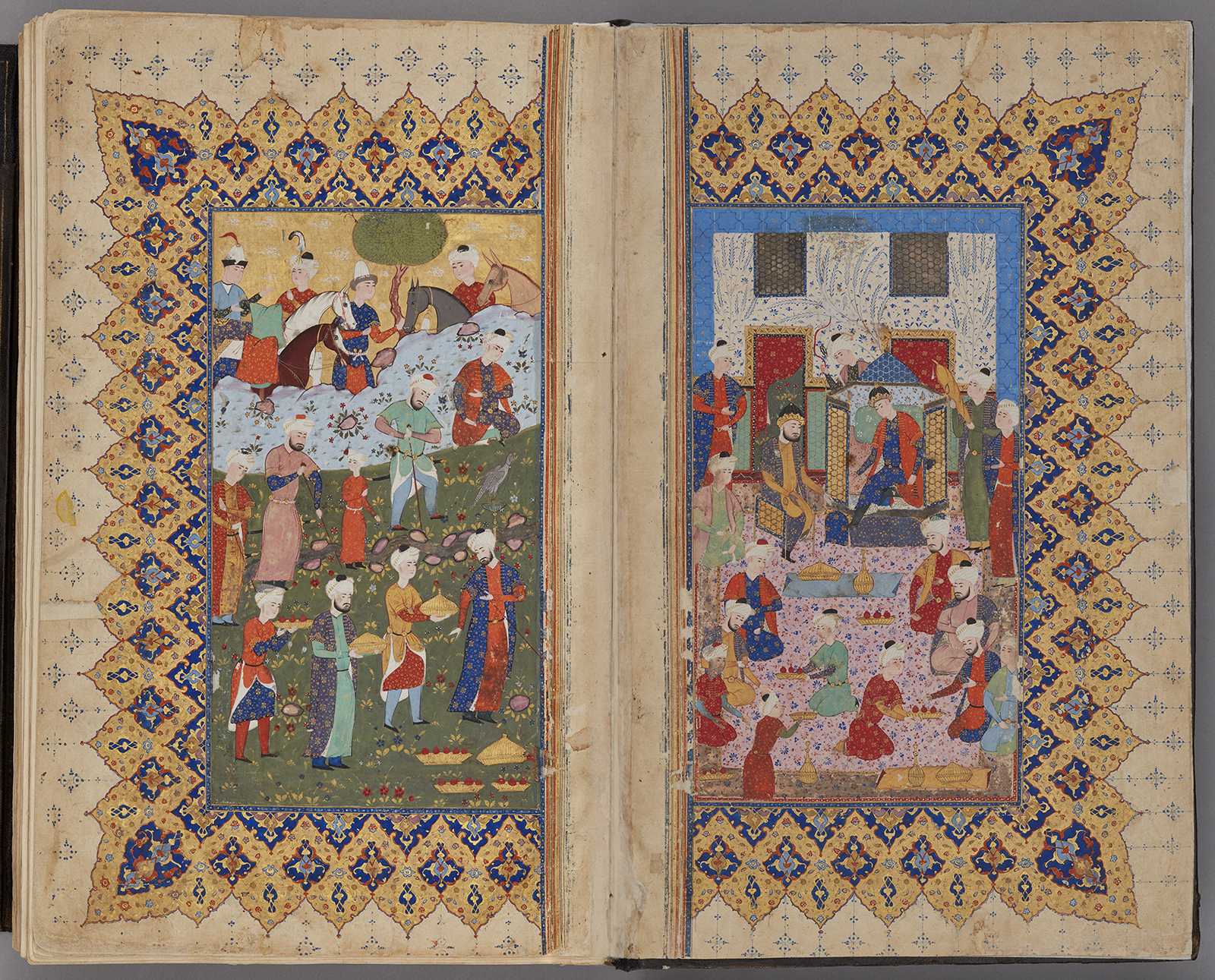Click on the image to zoom
Frontispiece, from a manuscript of Nigaristan
- Accession Number:AKM272.f1v
- Creator:Author: Ahmad b. Muhammad Ghaffari, Persian, died 1567 Scribe: Ahmad al-Shirazi
- Place:Iran, Shiraz (probably)
- Dimensions:38.7 cm × 25 cm × 6.4 cm
- Date:1573-74 CE/980 AH/AH 980
- Materials and Technique:Ink, opaque watercolour, and gold on paper
This double-page frontispiece is from an intact manuscript of the Kitab-i Nigaristan by Ahmad Muhammad Ghaffari (1504–67/68). Completed in 1552, the Kitab-i Nigaristan is a collection of historical anecdotes and incidents, written in prose and focusing largely on peculiarities in Iranian history. The manuscript’s 350 tales are narrated in chronological order, beginning with the Prophet and Imam Ali, continuing to the Abbasid caliphs and other rulers of Iran, and concluding with the Turkmen rulers. Dated 1573, this manuscript in the Aga Khan Museum Collection was copied by the scribe Ahmad Shirazi. It contains 44 illustrations executed in the Shiraz style.
See AKM272 for more information about the manuscript and links to the other illustrations.
Further Reading
Folio AKM272.f1v shows a view of an interior of a palace with a man enthroned in the horizontal centre of the picture field. To his left is another figure, also seated on a chair. Additional figures are arranged in the room in a circle around the crowned figure. Some are serving fruit and other delicacies.
The throne scene might suggest that the manuscript was a royal commission. The identity of the enthroned figure is not clear, however. Depictions of the biblical King Solomon, often seated on a throne, were a common motif in double-page frontispieces on Shiraz manuscripts produced during the late 15th to late 16th centuries. This figure was painted as the subject of the frontispiece regardless of whether Solomon played a role in the ensuing manuscript. Solomon, who appears in both the Old Testament and the Qur’an, is known as a religious figure. According to Islamic legend, he had the ability to mobilize jinns and dīvs or peris[1] to erect religious buildings. For this reason, many manuscripts of the period illustrate jinns next to Solomon's throne. Baǧci[2] argues that this iconography could reveal the painter's desire to associate his art with such an important religious figure.
AKM272.f2r shows the left part of the double-page frontispiece. It shows a view of an outdoor landscape with flowering plants and flowers. On this landscape, the figures are arranged in three diagonal rows parallel to each other. The figures in the front row, in the lowest register of the picture, are carrying food and fruit platters, possibly for the feast depicted on the next page. The figures in the middle level have a staff in their hands. A hunting bird—possibly a falcon—is also standing here at the edge of the stream, indicating a royal hunt. On the upper level of the painting, other figures are standing next to their horses. All of the figures in the painting have their bodies facing right. Since this side is placed opposite the throne side, the figures are facing this scene.
The double-page frontispiece AKM272.f1v and AKM272.f2r are the first painted leaves with sumptuous gold and lapis lazuli illuminations. Covering three sides of the illustrations, this ornamentation is called taḏhib, which means gilding in Arabic. Not surprisingly, the colour gold is very present in this type of decoration.
The illuminations are each arranged so that palmettes on a gold background decorate three sides of the illustration. Ornamental rays extend from the illuminations to the outer edge of the leaf. Called tašʿir, these fine ornaments are so named because they are as fine as a hair (šaʿr in Arabic).
Tašʿir is another type of decoration for illuminated pages in sumptuous manuscripts. It is usually applied with gold or another colour and with a very fine brush. The decorations are mostly in lapis lazuli as well as orange and white with fine strokes on a gold background.
- Elika Palenzona-Djalili
Notes
1. Living creatures mentioned in the Quran. See Massé in EI II, 560.
2. See Serpil Bağcı S: "A New Theme of the Shirazi Frontispiece Miniatures: The Dīvān of Solomon."
References
Baǧci, Serpil. "A New Theme of the Shirazi Frontispiece Miniatures: The Dīvān of Solomon," Muqarnas 12 (1995): 101–111
Note: This online resource is reviewed and updated on an ongoing basis. We are committed to improving this information and will revise and update knowledge about this object as it becomes available.




